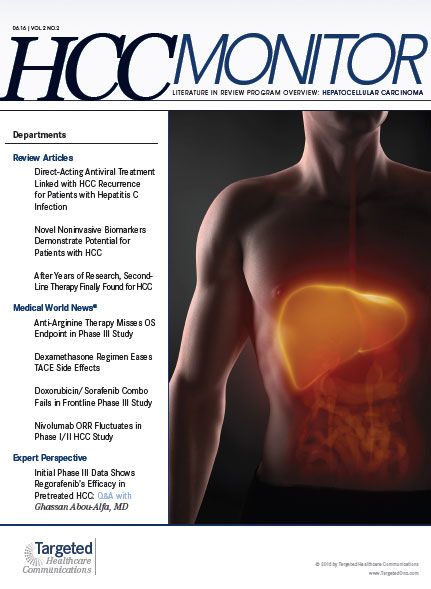Nivolumab ORR Fluctuates in Phase I/II HCC Study
Treatment with the PD-1 inhibitor nivolumab demonstrated an objective response rate of 9% as a second-line therapy for patients with hepatocellular carcinoma.
In previous findings from the study, the ORR was 19%; however, for the latest update, the investigators cautioned that data were preliminary and so they may have underestimated the response rate. In the study, responses were frequently delayed, with a complete response occurring after 24 months of treatment. When considering those with stable disease, the disease control rate was 65%.
“The updated nivolumab in HCC data are still very encouraging. The disease control rate was 65%, and there were 3 complete responses,” said Kabir Mody, MD, from the Mayo Clinic.
The phase I/II study explored ascending doses of nivolumab ranging from 0.1 mg/kg to 10 mg/kg every 2 weeks for up to 2 years. All patients enrolled had Child-Pugh class A disease. The primary endpoint was ORR by RECIST criteria. Secondary outcome measures focused on overall survival (OS), progression-free survival, and biomarker assessments.
In an expansion cohort, nivolumab was administered at 3 mg/kg across 4 groups, including those uninfected by hepatitis who were sorafenib naïve/intolerant, those uninfected following progression on sorafenib, those with hepatitis C virus (HCV) infection, and those with hepatitis B virus (HBV) infection.
Overall, 206 patients were enrolled in the study, 65% with extrahepatic metastasis and 7% with vascular invasion. Most patients had received prior sorafenib (64%).
Of enrolled patients, 91 had ≥18 weeks of follow-up and were evaluable for response. For those who responded to treatment, the median duration of response was 17 months (range, 6-24). Stable responses occurred as late as 12 to 18 months following the initiation of treatment. Overall, PD-L1 status did not appear to impact response rates. The 6-month OS rate was 69% (95% CI, 0.43-0.85).
For uninfected, sorafenib-naïve or intolerant patients (n = 22), the ORR was 14%. In those who progressed on prior sorafenib and were uninfected (n = 27), the ORR was 7%. In the HCV-infected (n = 21) and HBV-infected (n = 21) patients, the ORRs were 14% and 0%, respectively.
Across all cohorts of the trial, patients received 5 to 6 doses of nivolumab (range, 1-19). Half of patients experienced a treatment-related adverse event (AE), with the most frequent events being fatigue (17%) and pruritus (12%). Grade 3/4 treatment-related AEs were seen in 14% of patients, with the most common being ALT and AST increases (3% each).
In the frontline setting, nivolumab is being compared with sorafenib for patients with HCC in a phase III study. The primary endpoints are time to progression and OS. The study hopes to enroll 726 patients with an estimated completion date of July 2017 (NCT02576509).
REFERENCE
- Sangro B, Melero I, Ya TC, et al. Safety and antitumor activity of nivolumab (nivo) in patients (pts) with advanced hepatocellular carcinoma (HCC): Interim analysis of dose-expansion cohorts from the phase 1/2 CheckMate-040 study.J Clin Oncol.2016;34 (suppl; abstr 4078).

Survivorship Care Promotes Evidence-Based Approaches for Quality of Life and Beyond
March 21st 2025Frank J. Penedo, PhD, explains the challenges of survivorship care for patients with cancer and how he implements programs to support patients’ emotional, physical, and practical needs.
Read More





